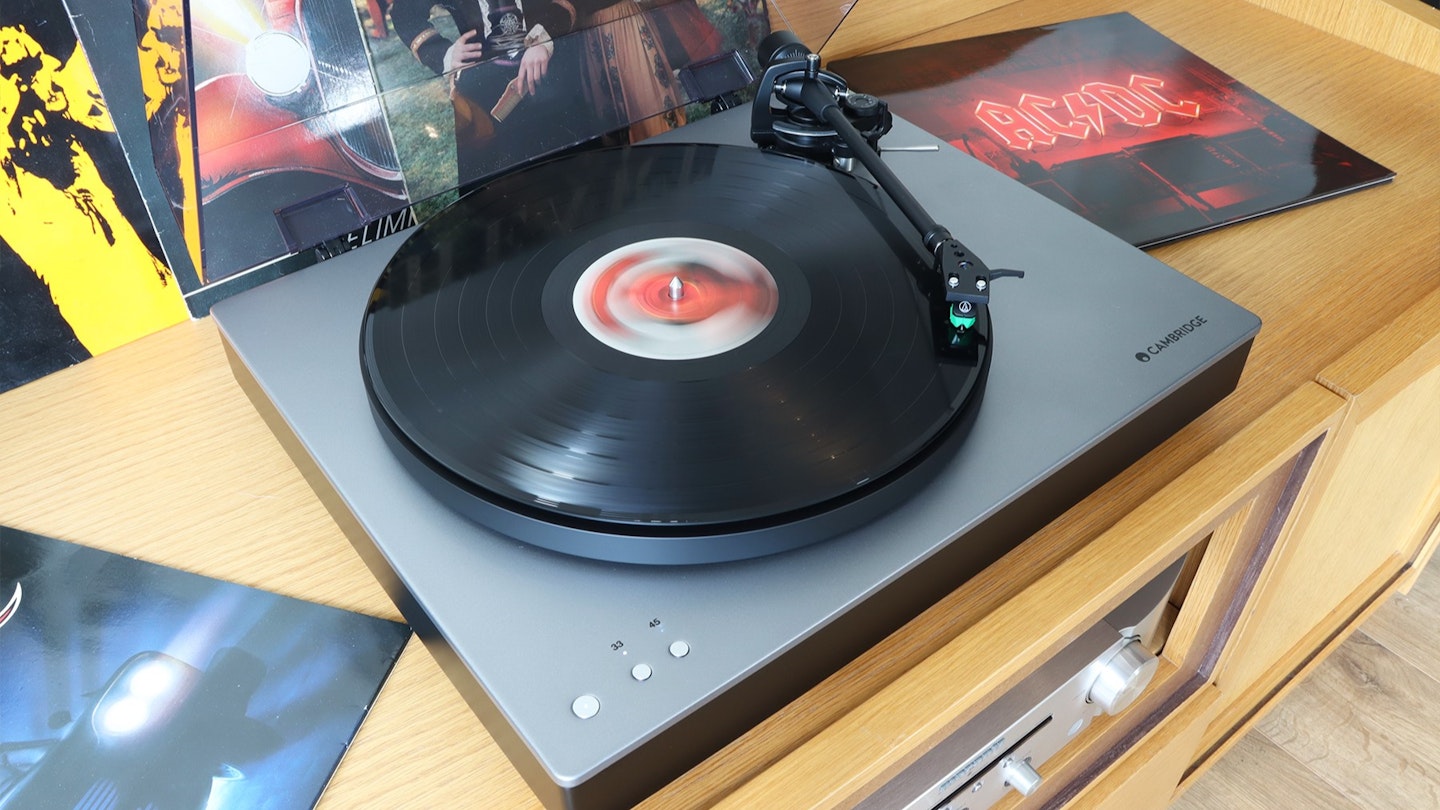Long-established provider of high-end audio equipment, Cambridge Audio, released its Alva ST turntable to enthusiastic response not so long ago. And, on the face of it, it’s easy to see why initial reactions were so positive. Taking a glance at the Cambridge Audio Alva ST, with its minimalist lines and understated yet sophisticated looks, this is a turntable that will turn heads if nothing else.
As it happens, there is indeed a lot more going on here. First, it offers a lot of solid engineering and design finesse at a sensible price. That makes it attractive to both audiophiles and vinyl enthusiasts. And second, it sets out to make listening as smooth and seamless as possible. That ethos translates into several key areas throughout the build. The sleek yet weighty deck, redesigned tonearm and removable headshell appeal to serious vinyl heads. As does the belt drive with electronic motor control. But remember, a sizable wedge of Cambridge Audio’s proposition here is to streamline all listening options. That means the Alva ST turntable also comes with high-quality implementations of Bluetooth with aptX HD. Plus, a built-in phono stage borrowed from the Alva Duo - a deck that costs over twice as much.
So, it promises a lot. But can the wide appeal of the Cambridge Audio Alva ST turntable satisfy both the high-end separates crowd and those who want hassle-free wireless listening? Our audio expert, Chris Duffill, has swapped out his vintage DUAL deck to give the Alva ST a workout. Was it a revolutionary experience, or a case of spin over substance?
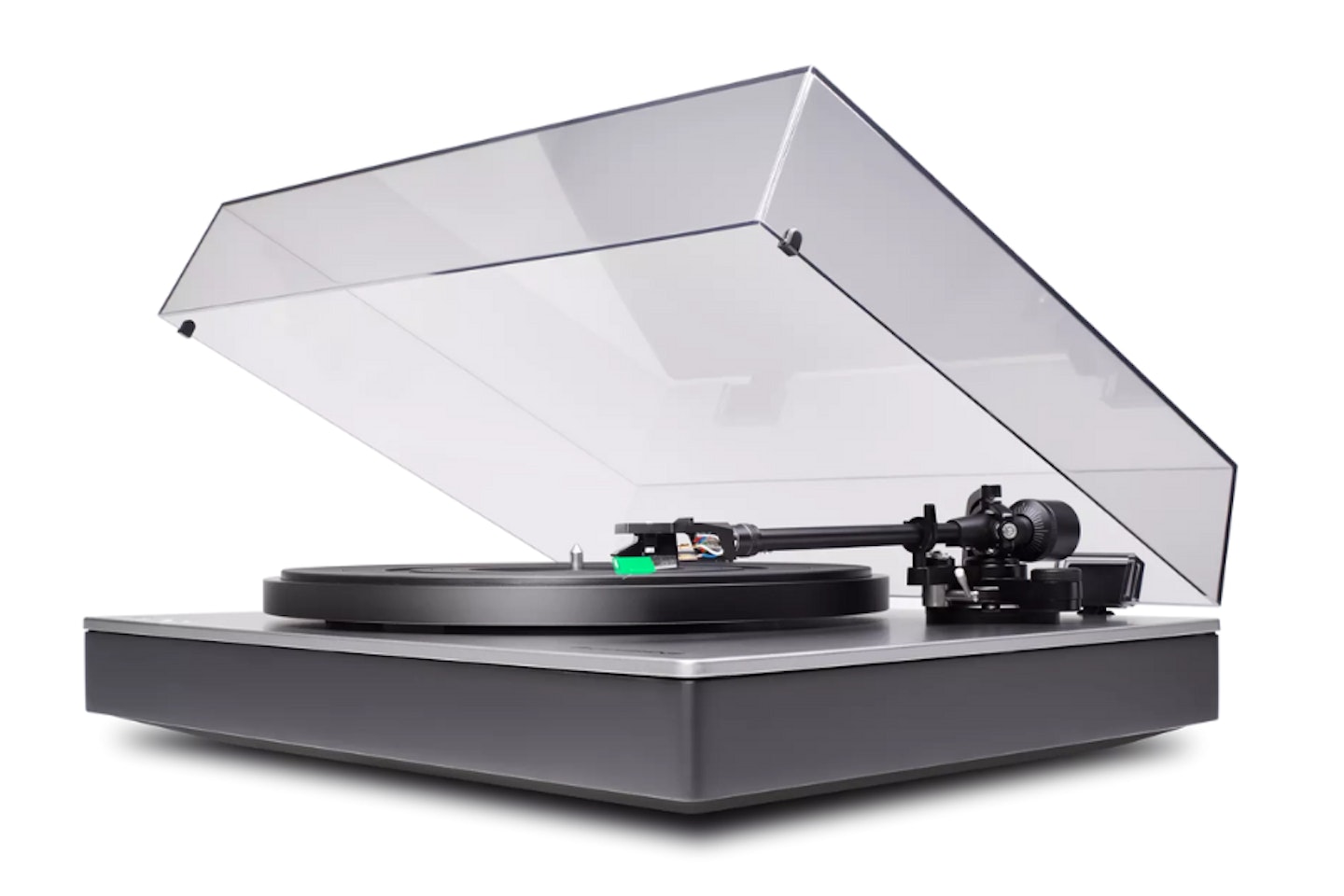
www.richersounds.com
Pros
- Superbly built and engineered for stability and clarity
- Well-specified pre-aligned MM cartridge and stylus works with the platter and tonearm design for optimum performance
- Bluetooth connectivity that supports high-resolution audio is ideal for hassle-free listening
- Flexible turntable for those who don't have an amp with a phono stage thanks to the Alva's built-in preamp
- Removable headshell provides easy upgrade options
Cons
- No 78 rpm option
- Despite being a well-renowned cartridge that functions very well, it is bright green and can cheapen the look
| Drive type: | Belt |
| Turntable speeds: | 33 1/3, 45 rpm |
| Wow and flutter: | <0.12% |
| Platter: | Die Cast Aluminium, 645.3g (930.5g inc. rubber mat) |
| Phono stage: | Yes |
| Cartridge / Stylus: | Audio Technica AT-95E, Moving magnet |
| Overall weight: | 9kg |
| Dimensions: | 435 x 139 x 367 |
| Extra features: | Dustcover, Removable headshell, Ortofon stylus gauge, Bluetooth 5.3 with SBC/aptX/aptX HD codecs |
- Customer review: "I’ve had this turntable for a month now, and it’s really blown me away. The build and sound quality is exceptional and being able to easily connect to my KEF LS50 Wireless II adds makes listening to vinyl a quick and easy experience without a bulky system. The sound quality is really good as well."
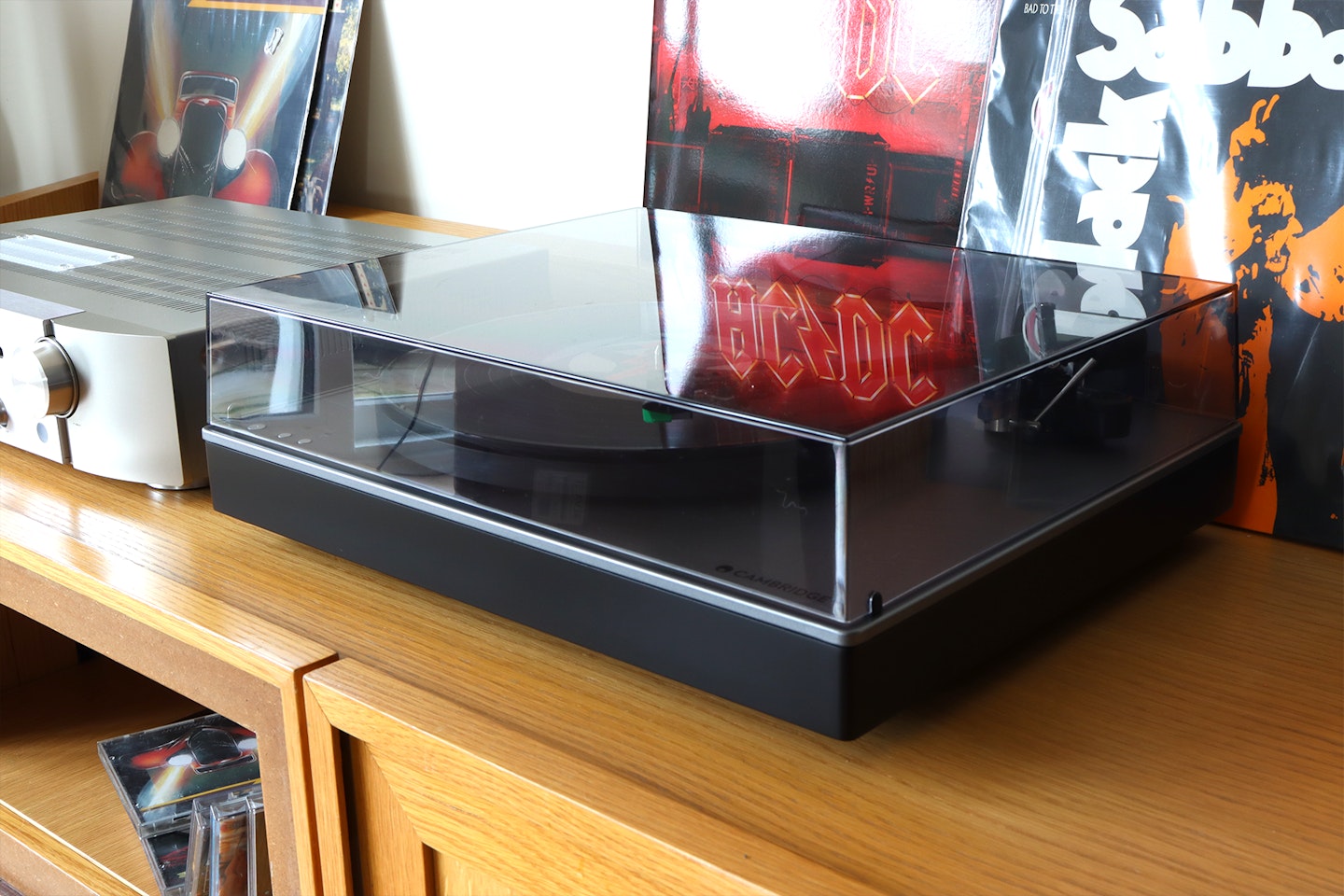
Setting up
I’ve owned a few turntables over the years. Like all good audio journeys, mine began with the cheapest and nastiest record players known to man. I still remember the awe and excitement of unpacking my Amstrad tower system sometime in 1984. When it failed (which, of course, it did), I hovered over the engineer’s shoulder as he removed the back panel. Instead of seeing the shiny high-tech innards of a thoroughly modern hi-fi, a Spaghetti Junction of multicoloured wires lolled out from what was a largely empty cavity.
I hopscotched from system to system, taking in equally hollow Philips midi systems and the like. I finally saved up for my first ‘proper’ set of separates - a NAD receiver, AR speakers and a DUAL deck. It was a complete revelation. I revisited all of my LPs and started to twig what all the fuss was about. So, cut to today, and I’m lifting the Cambridge Audio Alva ST from its packaging.
Even before I took the wrapping off, the sheer weight of this deck took me right back to the first time I set up that NAD system. It’s impressive, at around 9kg. As weight is the first thing I notice about any turntable, this would seem to bode very well. Having unpacked everything, I set about doing some construction.
Design and build
Cambridge Audio may have designed this turntable to be simple to use, but it's supplied in several pieces. And that’s a good thing. Aside from being cost-effective, the company clearly knows its customers. If there's one thing that vinyl fans love it’s the ritual of owning and operating their equipment. So, some minor assembly lets you feel the weight of the platter and see the belt mechanism - all plusses in my book.
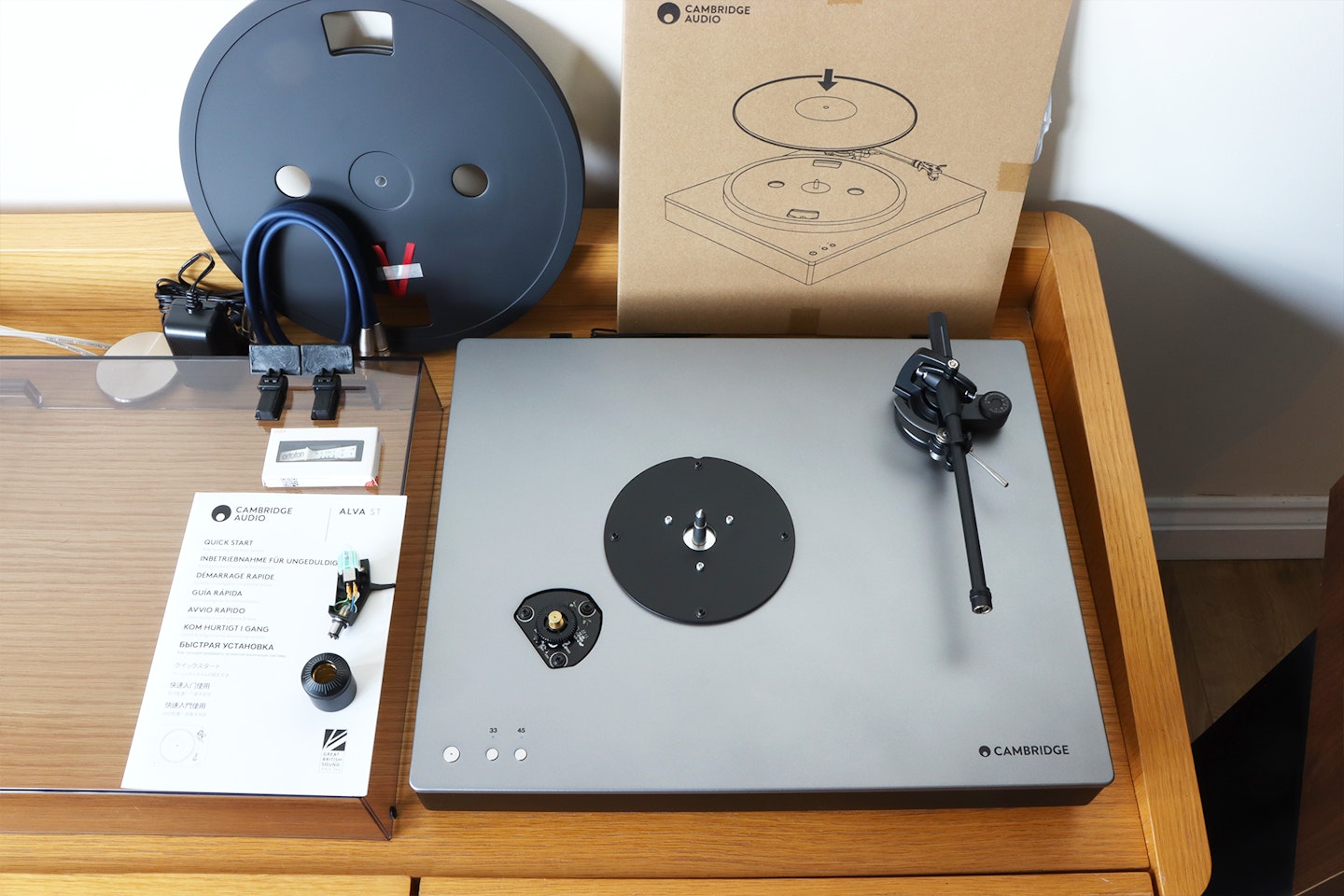
Plinth and stability
First, I wanted to see if all 9kg of the Alva ST was well-supported, well-isolated and stable. Without it, no stylus would end up sounding its best. Thankfully, the plinth itself is responsible for much of the weight. Deep down it’s MDF - great for uniform density - with a rubber polymer top layer. It's all finished off with a 1mm aluminium top plate. Cambridge Audio say this is excellent for sound absorption - highly likely, given the overall build quality.
For stability there are two dense rubber strips built into the base. They’re not the small adhesive type and feel very solid. I also appreciate that the front half of the deck benefits from the most support. There’s no mechanical dampening of the feet at play here, so I knew that the system as a whole would need to be well-isolated from the deck.
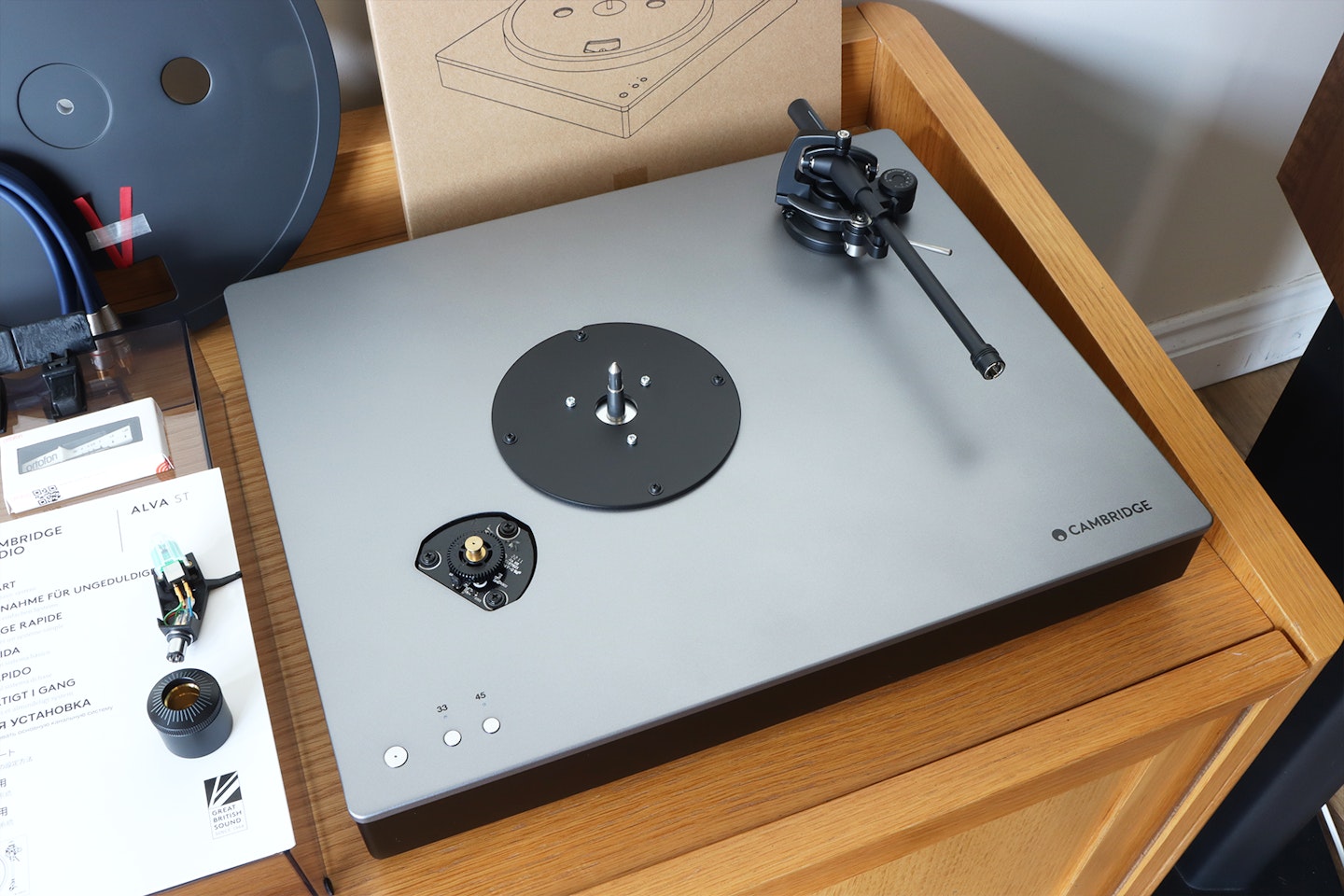
Platter and belt
The solid die-cast aluminium platter is reassuringly weighty at 645.3g (930.5g including the rubber slipmat). Cambridge Audio has milled this by computer control for a smooth and perfectly level surface - and I can believe it. It’s chunky enough too, at 17mm. Although slipmats are a bone of contention for vinyl fans, this one comes with a 5mm rubber mat. Rubber does have its pros and cons, as does cork and felt. But, as far as limiting unwanted resonance goes, it’s a good match for the aluminium underneath.
I slotted it onto the spindle and used the handy pre-attached ribbon to thread the belt. The Alva ST, like many of the best DJ decks, opts for the tried-and-tested belt-driven design. It's generally preferred for sound isolation from the motor - something that often plagues direct-drive models.
A ground cable and a heavyweight CA phono cable are included, so I attached both of those ready for connection to the amp. With the tinted dust cover also attached using the two spring clips, I moved on to the really interesting stuff.
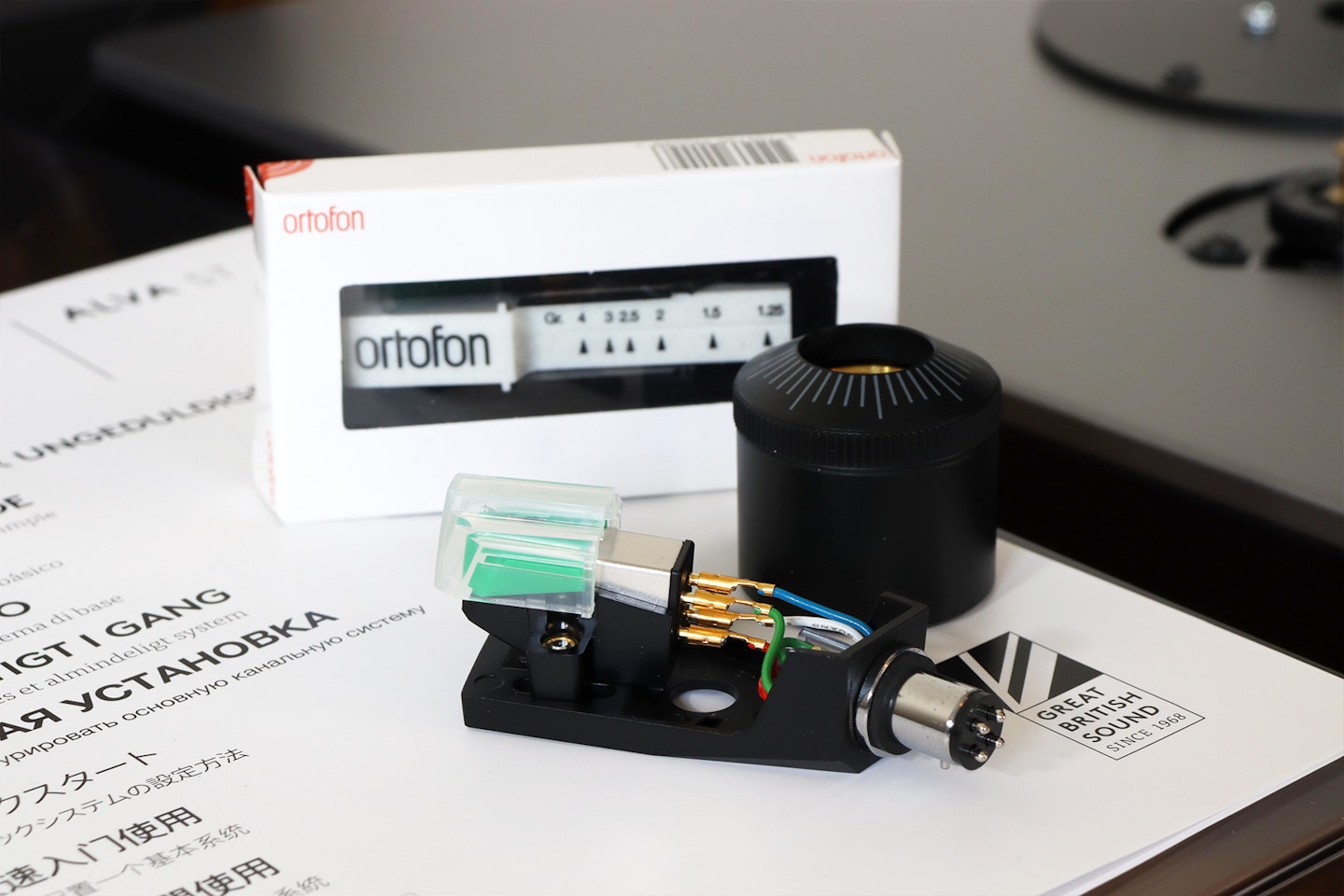
Tonearm
Unlike the more expensive Alva TT V2, the tonearm here is an alloy tube. But it's super lightweight at only 19g and well-balanced thanks to the smooth-moving counterweight. The surrounding mechanism is solid too, with the metal queue lever being a good size and easy to handle. I really like that the lever, and the anti-skating dial, are nicely positioned for easy access without fouling the tonearm.

Headshell, cartridge, and stylus
I always find it reassuring to unpack a deck and see a tonearm without a pre-fitted headshell. Again, it’s an essential but small part of the learning curve for anyone relatively new to turntables. Fitting is super-easy - aligning the pins and screwing on the collar. The benefits here are huge. Not only does it let you easily swap out your fixed-stylus cartridge to suit your music, but it also means you have a bit of freedom with the headshell itself. That means you can choose others that are better-matched with other cartridges (many also with pre-aligned styluses).
Here, Cambridge Audio has selected a tried-and-tested Audio Technica AT-95E cartridge which they claim is 'perfectly matched'. It’s a moving magnet model with a wide frequency response and an elliptical stylus - a profile that's supposed to track well and maintain good contact with the groove.
But, by far the best feature here is that all of the above comes pre-assembled and - importantly - pre-aligned. So, no need to fret about using alignment gauges on the platter to ensure good tracking.
Balancing the tonearm
Having balanced the tonearm horizontally, I set about applying the right tracking force for the cartridge. I really appreciated the inclusion of a manual Ortofon stylus gauge. The cartridge is supposed to have a tracking force of 2 grams. So, placing the needle on the 2g mark until the gauge was balanced was super-simple. Still, given this is really done by eyeballing the gauge, I still wanted to checks against some digital scales. It was pretty much spot-on.

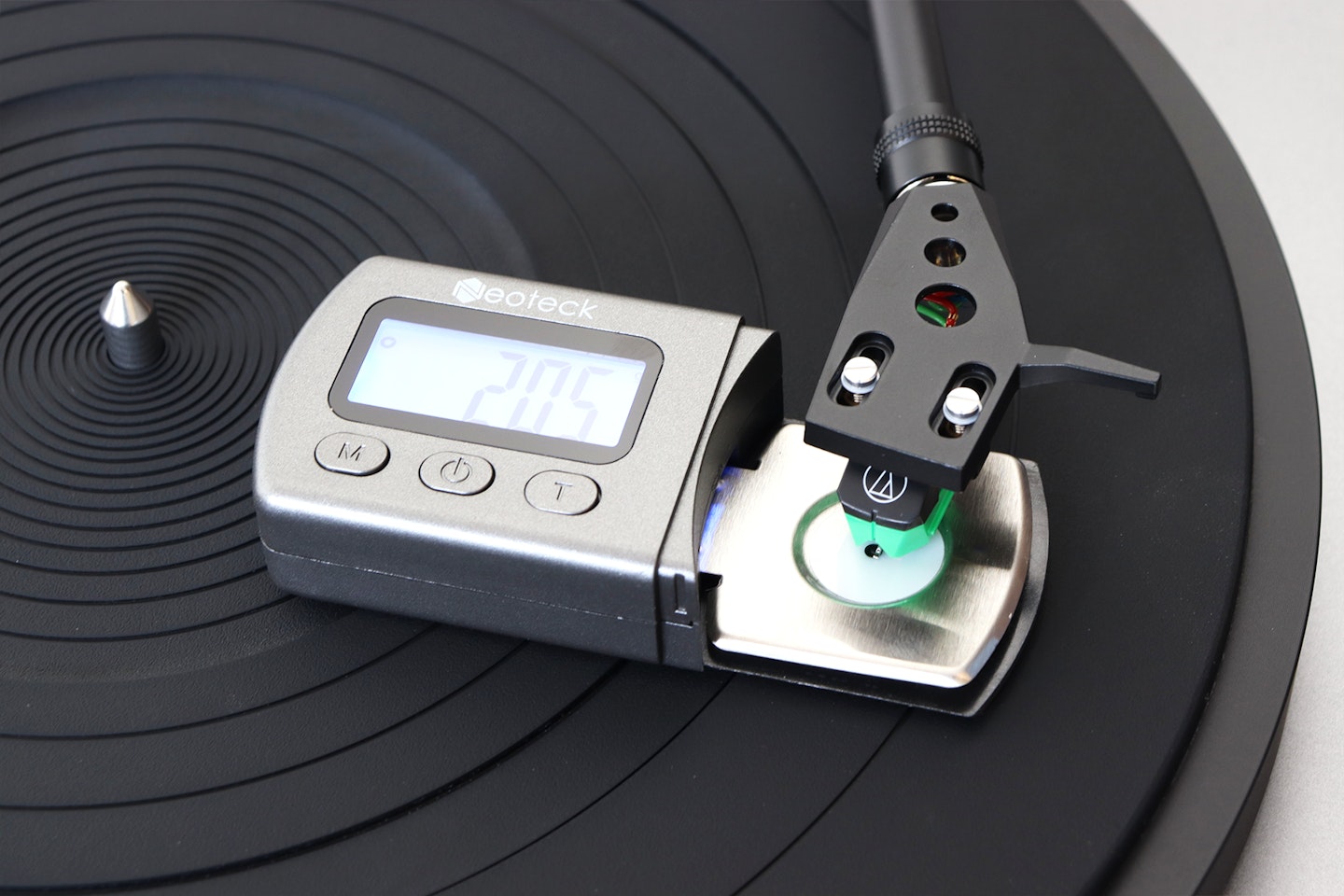
Overall design and build
Standing back to take in the Cambridge Audio Alva ST in its entirety for the first time, it’s a beautifully understated design with plenty of sophistication. And that’s largely down to the lunar-grey aluminium top plate and matt black plinth. I happen to love the two-tone grey and black aesthetic, as well as the Cambridge Audio floating wedge base. It gives the illusion of being suspended on much taller feet.
The dust cover is a tinted grey plastic lid that has some very well-designed sprung hinges. I’ve owned a few turntables with stuff, clip-type hinges that end up fracturing the plastic over time. These are tensioned pretty much perfectly.

Controls and outputs
Back panel and modes
So, the back panel of any device isn’t often something to rave about. After all, once you’ve seen all of the available jacks and switches you’re done. But, Cambridge Audio really demonstrate that they’re also turntable users through and through. The simple addition of additional upside-down labelling at the top of each section. That means that once you’ve set up your deck you won’t have to unhook or shuffle things around to see behind the machine. A quick peek over the top is all that’s needed to easily find the preamp and Bluetooth switches and more.
Yes, you have an RCA phono output and ground wire connections. But, a notable addition here is the option to toggle between the phono out and the internal preamp ‘Line’ output. That means it can be wired to an amp without a phono stage and also supports the Bluetooth function.
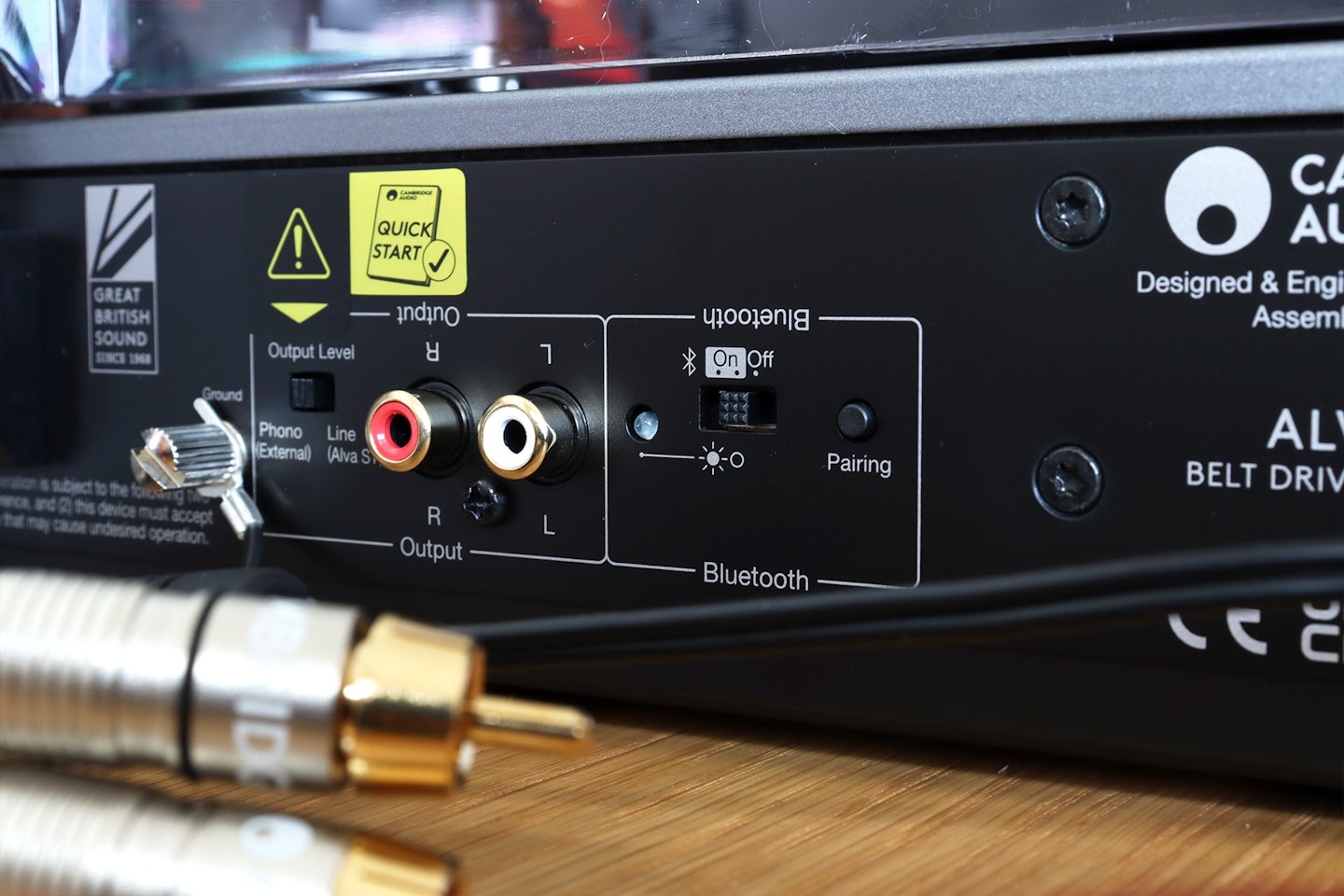
Power and speed settings
Before I got to spin some tunes, the last step was to check the controls. They’re simplicity itself - three buttons with LEDs for power and speeds. Turning the deck on and selecting 33 RPM, I was really pleased to hear nothing. No ground issues or motor noise.
I decided to check the Cambridge Audio Alva ST’s claim that the electronic motor speed control was responsive and accurate. Using a reasonably scientific iPhone app for this, I found that both speeds were well within tolerance - with 33 ⅓ almost spot on. 45 was the same story. This turntable is seriously accurate right out of the box and gets up to speed fast.

Performance and sound
So, with all of the geeky stuff out of the way, I was finally able to dig through my crates for some top-quality grooves.
In the spirit of old-school analogue audio, I started out testing the Cambridge Audio Alva ST on my vintage NAD receiver and bookshelf speakers. However, part of the way through, my much-loved NAD 7020E gave up the ghost. Despite feeling a bit deflated, it did give me a good excuse to hook the Alva up to a modern system - a Marantz PM6007 and KEF Q530 speakers.
So, as you’d expect, this is the part where everything becomes highly subjective. If there’s any area of tech that invites a million opposing opinions it’s hi-fi, with vinyl right at the top of the homegrown advice tree. Everyone’s experience with any deck will vary wildly from system to system. Some of the best amplifiers for turntables have a number of features (sometimes even a lack of features) that can aid with analogue listening.
AC/DC’s Power Up was first on the platter and a high-volume session really did show off the Alva’s well-defined soundstage and isolation. Next was more rock, with ZZ-Top’s Eliminator which really put the bass response to the test with thumping tracks like ‘Gimme All Your Lovin’ and ‘Sharp Dressed Man’. Shifting things down a notch, ‘Love Alive’ (the largely acoustic track from the LP Little Queen by Heart) was detailed with a musicality that took me by surprise. When the bass and drums kick in later in the track, the harmonic range of the Alva is just stunning.
Over to some alternative dance albums for a moment, and a new pressing of New Order’s Technique. This really did show off the versatility of the deck. It pushed all of the frequencies to the max. The original soundtrack to John Carpenter’s Christine came next, with a mixture of genres including 50s rock and roll and synth. 45s were next, with some orchestral tracks from John Williams, including the stirring Flying Theme from E.T. My session expanded far beyond what I’d intended for a first-listen. That's a testament to the experience offered by the Cambridge Audio Alva ST on all counts.
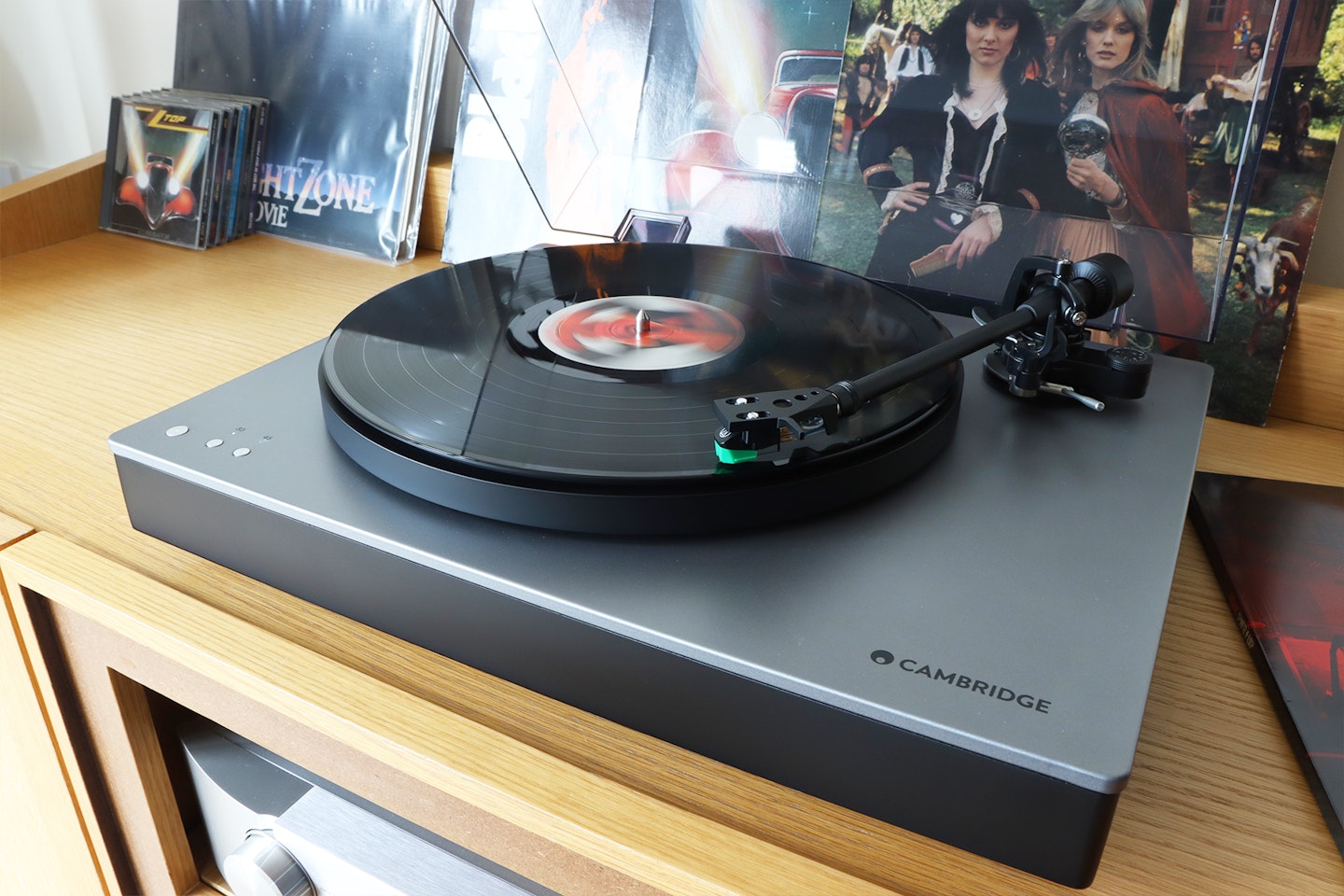
Bluetooth
Breaking myself away from my record collection for a moment, it was time to test out the Bluetooth functionality. Now, although this can pair with any Bluetooth-enabled speakers or headphones, it’s definitely worth mentioning that this is no afterthought. Knowing that a good number of Alva ST users will be drawn by the easy setup and playback options, the implementation of Bluetooth 5.3 allows for aptX and aptX HD codecs. That means high-resolution audio.
It’s really crucial here that you pay attention to the settings on the back panel. Hooking the deck up to an amplifier with a phono stage could cause damage if the Alva ST output is set to Line instead of Phono. Bluetooth won’t work at all unless you select Line output as it will need to amplify the sound first.
Unlike some lesser audio gadgets, the Cambridge Audio Alva ST’s Bluetooth has been nicely implemented. It’s fast and easy to connect, and I hooked mine up to the Edifier WH950NB headphones I reviewed recently. They don’t support the aptX standard for high-res audio, but given that I generally listen to vinyl in as analogue a way as possible, this was more than adequate for me.
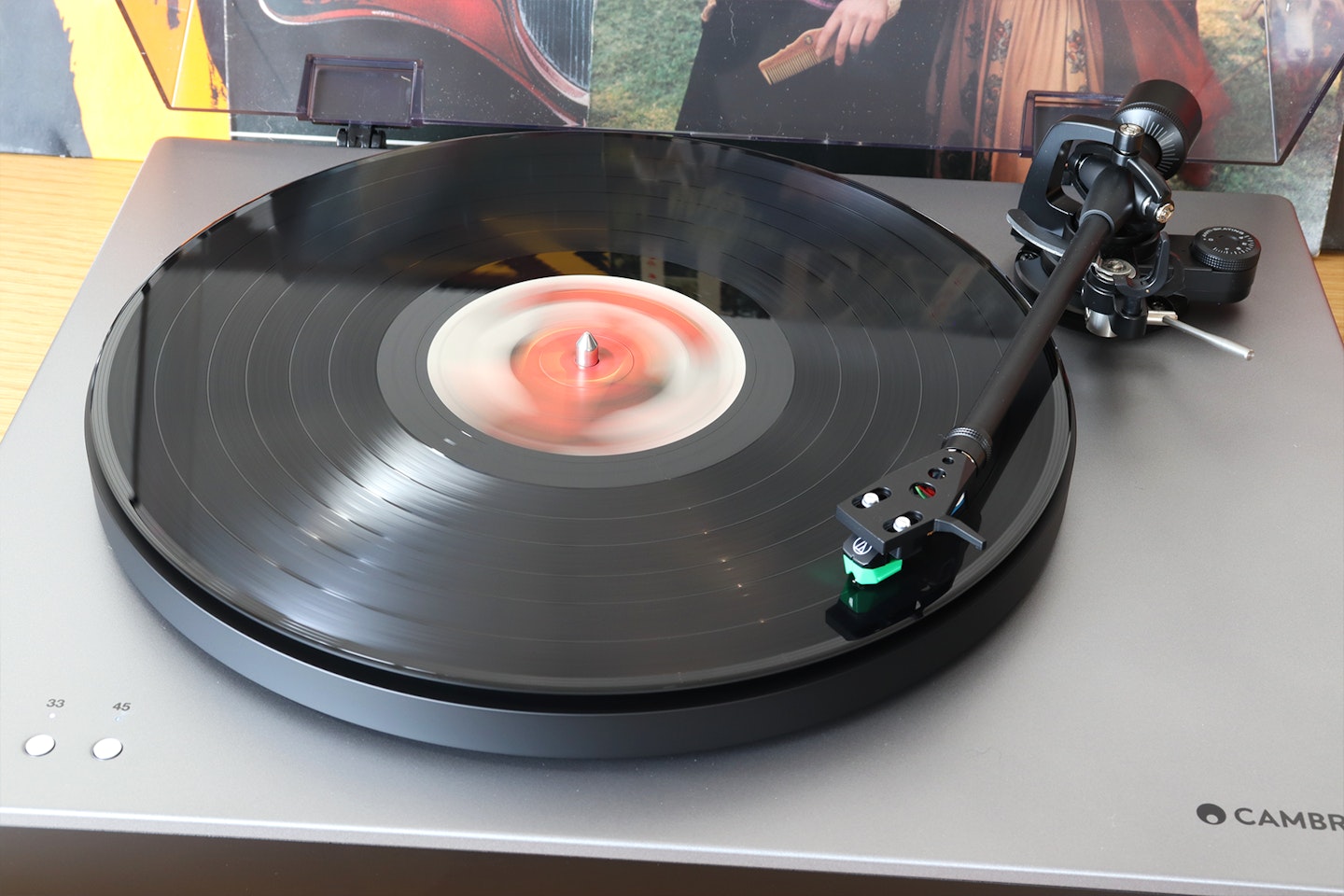
Any downsides?
To be frank, ‘downsides’ is perhaps too strong a word. My criticisms here are minor nitpicks at best. Firstly (and this will apply to any turntable) I do wish that cartridge casing colour schemes were toned down a tad. A machine like the Alva ST is a thing of minimalistic beauty. The lunar grey upper plinth with matt black below is crowned with the tinted dust cover, offering simplicity and style. Then there’s a bright green piece of plastic on the end of the tonearm.
Not many listeners collect 78s - but a sizable portion do. There’s no 78 rpm here - but, granted, this is a bit of a specialism; especially since this would require a different stylus altogether.
Lastly, those rubber feet underneath are excellent for stability where it counts, but they don’t have any dampening. So, it’s essential to have this on a flat and level surface with good isolation from any speakers. That means the Alva may be a bit more unforgiving in more compact setups during louder sessions if the speakers are close by.
That said, Cambridge Audio are right on the money here. Moving your speakers onto the wall or floor and investing in good isolation is optimal setup-wise anyway. At the very least, it might give you an excuse to also invest in a new vinyl record storage unit for your collection.
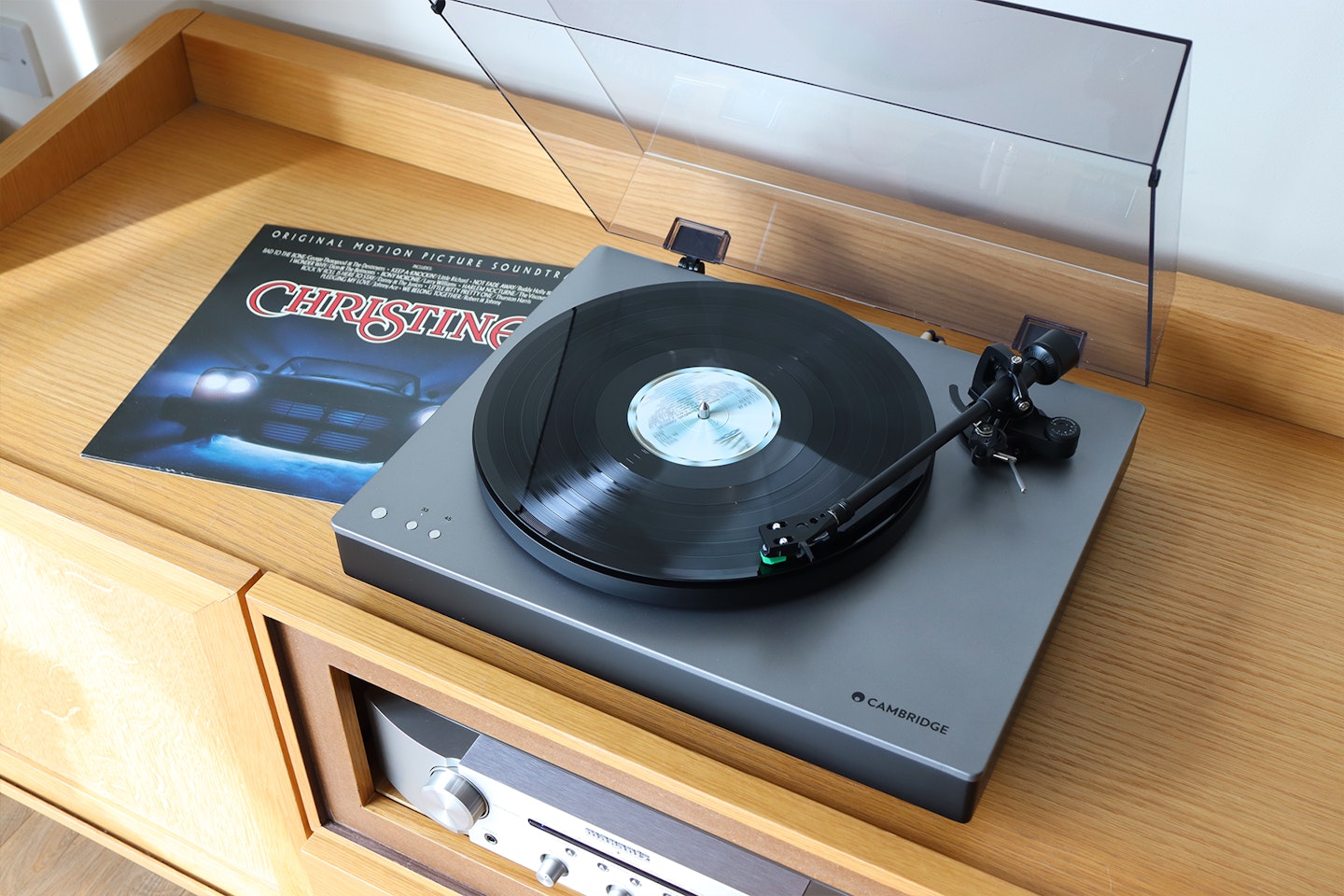
Price and competition
At well under the £1000 mark, the Cambridge Audio Alva ST is something of a landmark deck from this premium brand. After all, it’s offering a seriously solid build and a lot of audio know-how inside a package that includes mod cons like Bluetooth and a removable headshell. If you’re in the market for something similar, your options will be more than a little limited. A high-end turntable with high-res Bluetooth audio support is a bit of a rare beast.
Just in terms of cost and aesthetics, I would look at the Dual CS 618Q turntable which costs a little more than the Alva ST. It has no Bluetooth but does come with an Ortofon 2M Blue pickup and is fully automatic. Undercutting the Alva in price and spec is the Pro-Ject Debut PRO. It offers a similar minimalist design, and 78 rpm, but lacks Bluetooth and the overall heft of the Alva ST.
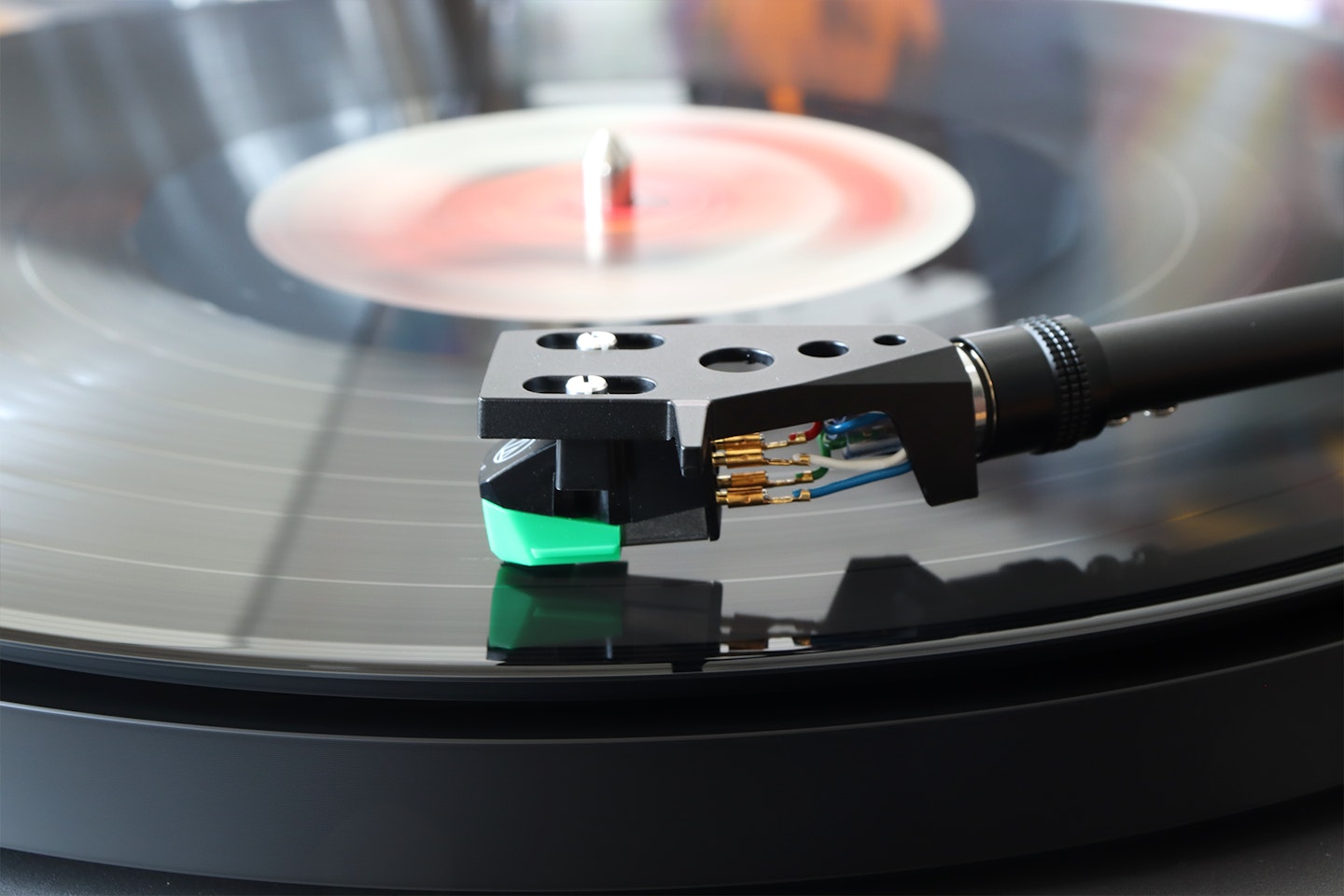
Verdict
Clearly, that AT95E cartridge with its elliptical stylus is a great fit for all grooves. For me, paired with the Marantz and KEFs, I found the Alva ST to be a highly capable turntable with a smooth but precise sound. Clearly, the range of the stylus and tonearm design has been extremely well-considered by Cambridge Audio’s engineers. I could not detect any unwanted frequencies being transferred through the tonearm or platter, and the Audio Technica stylus was responsive. There was a slight roll-off at the very top end that might sound a little less bright than some others; particularly for high vocals; but this is easily compensated for.
I was pretty much blown away by how forgiving this deck is with records that are in less than pristine condition. As Ultrasonic vinyl record cleaners aren’t for everyone, my collection has only had the usual brush, pad and spray treatment. As a fair test, I only used a carbon fibre brush on the vinyl before each play; whether the LP was an unplayed new pressing or a well-spun copy of Bowie’s Let’s Dance from the 80s.
The strapline ‘Just add vinyl’ has accompanied Cambridge Audio turntables for a while now - and I’m only too happy to oblige.

www.richersounds.com
Pros
- Superbly built and engineered for stability and clarity
- Well-specified pre-aligned MM cartridge and stylus works with the platter and tonearm design for optimum performance
- Bluetooth connectivity that supports high-resolution audio is ideal for hassle-free listening
- Flexible turntable for those who don't have an amp with a phono stage thanks to the Alva's built-in preamp
- Removable headshell provides easy upgrade options
Cons
- No 78 rpm option
- Despite being a well-renowned cartridge that functions very well, it is bright green and can cheapen the look
| Drive type: | Belt |
| Turntable speeds: | 33 1/3, 45 rpm |
| Wow and flutter: | <0.12% |
| Platter: | Die Cast Aluminium, 645.3g (930.5g inc. rubber mat) |
| Phono stage: | Yes |
| Cartridge / Stylus: | Audio Technica AT-95E, Moving magnet |
| Overall weight: | 9kg |
| Dimensions: | 435 x 139 x 367 |
| Extra features: | Dustcover, Removable headshell, Ortofon stylus gauge, Bluetooth 5.3 with SBC/aptX/aptX HD codecs |
- Customer review: "I’ve had this turntable for a month now, and it’s really blown me away. The build and sound quality is exceptional and being able to easily connect to my KEF LS50 Wireless II adds makes listening to vinyl a quick and easy experience without a bulky system. The sound quality is really good as well."
More items to consider
Best alternative to the Alva ST for overall build quality
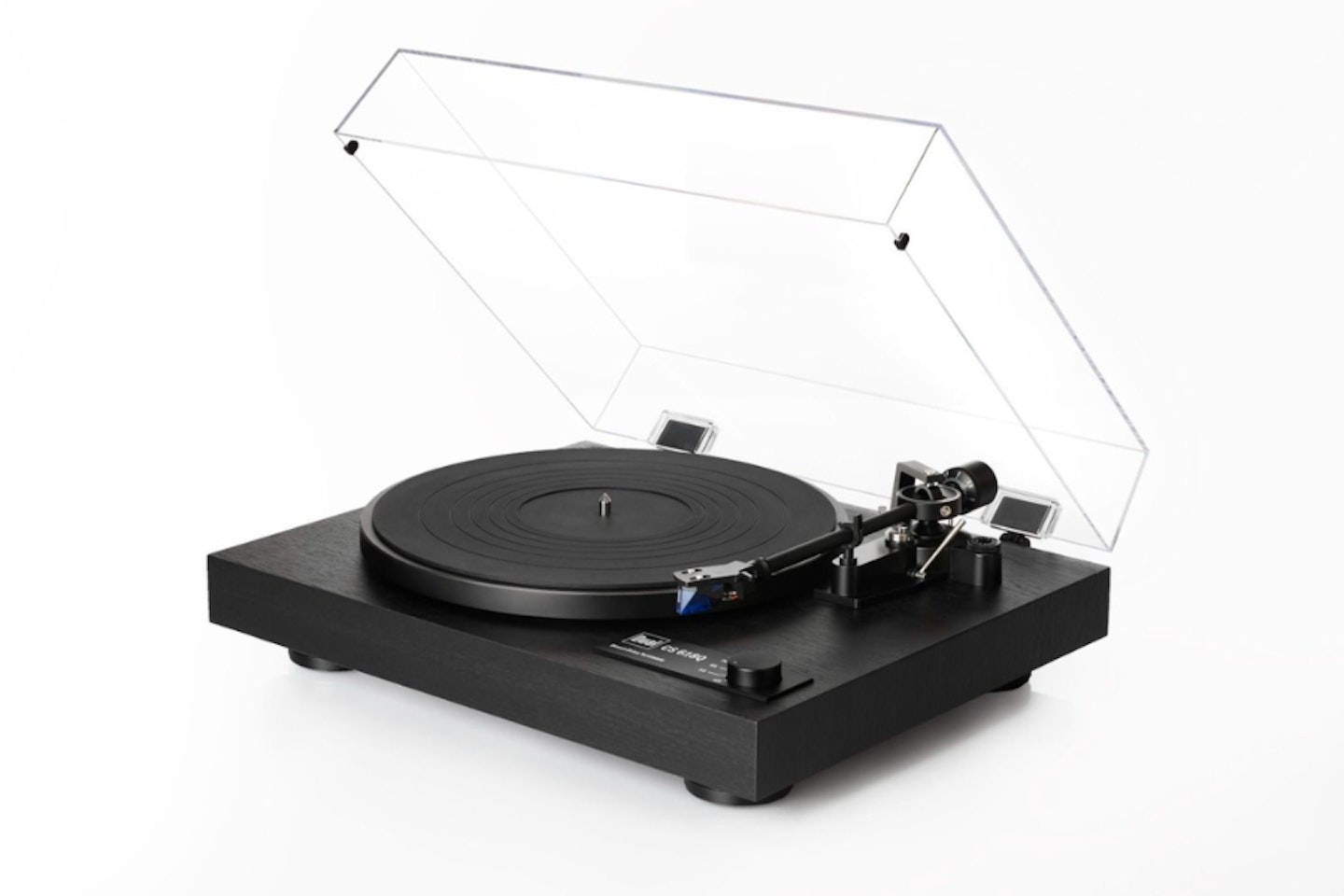
petertyson.co.uk
For those looking for a deck with a similar build quality to the Alva St, this Dual CS 618Q is a great option. Not only will you get that famous Dual design and construction, it also comes with the lauded Ortofon 2M Blue cartridge fitted. There's no high-res Bluetooth though, and the plinth is lighter than that of the Alva.
Pros
- Fitted with an Ortofon 2M Blue cartridge for excellent well-renowned performance and sound
- Auto stop / start feature for fuss-free operation
- Has 78 rpm speed selection
- Excellent veneer or gloss finishes to choose from for a classy look and feel
Cons
- No Bluetooth
- Direct drive motor isn't everyone's first choice
- Lighter plinth than the Alva ST
| Drive type: | Direct drive |
| Turntable speeds: | 33 1/3, 45 / 78 rpm |
| Wow and flutter: | < ±0,07 % |
| Platter: | Die Cast Aluminium, 1450g inc. mat |
| Phono stage: | Yes |
| Cartridge / Stylus: | Ortofon 2M blue |
| Overall weight: | 7kg |
| Dimensions: | 435 x 367 x 145 mm |
| Extra features: | Auto-stop / auto tonearm lift, twin gimbal precision tonearm, anti skating dial |
- Customer review: "Outstanding sound quality & build. Whisper quiet through my Denon AVR & Matin Logan speakers & sub…Easy set-up. I'd recommend picking up a stylus scale gauge. The blue Ortifon cartridge brings the music to life."
Best alternative to the Alva ST for aesthetics
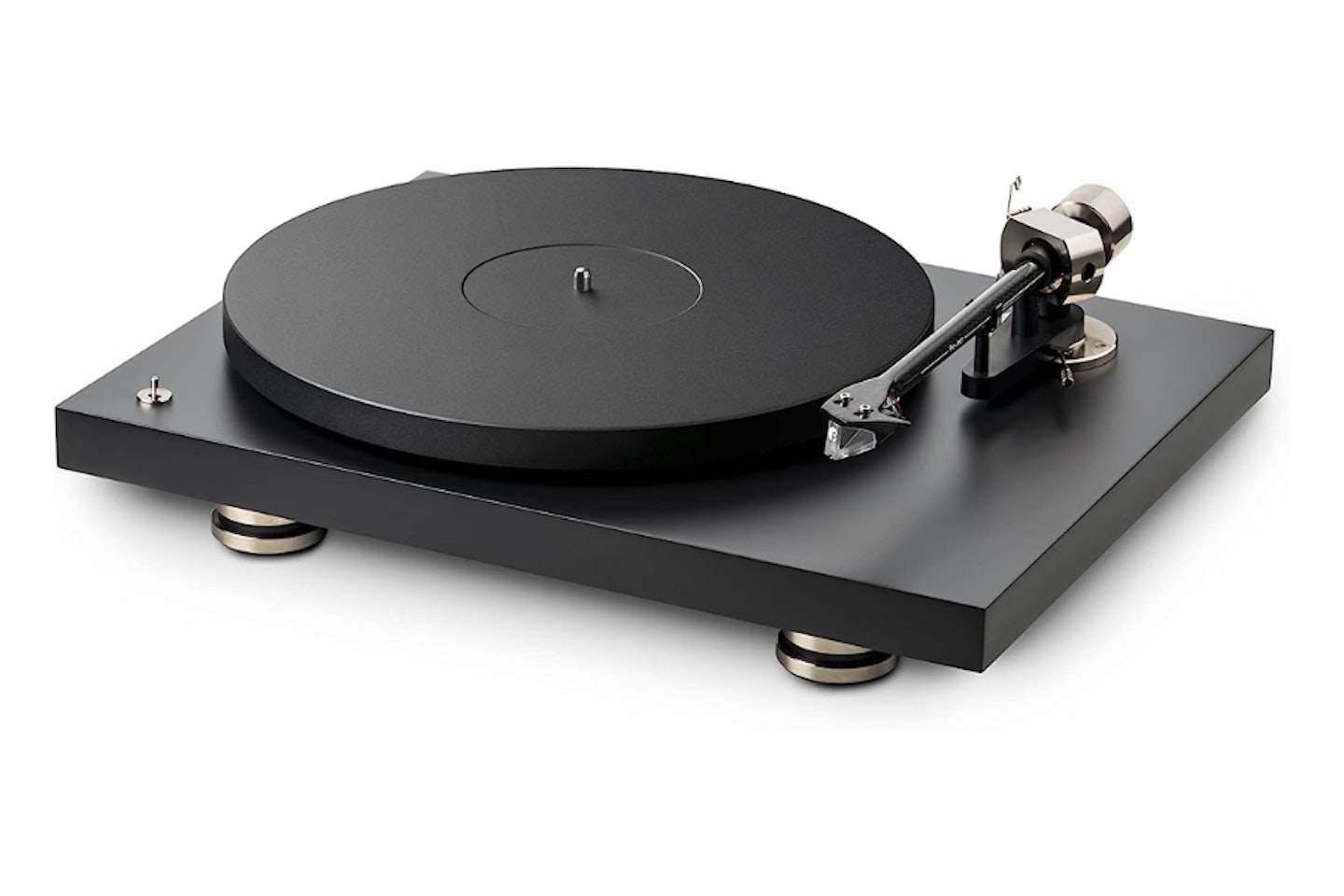
If you're a fan of the Cambridge Audio minimalist look, but can't quite stretch to the Alva ST, this Pro-Ject could be a good alternative. You won't get a phono stage, or Bluetooth, but you do have three speeds an an electronically controlled motor. It's a belt drive too, and it looks modern yet understated.
Pros
- Sleek minimalist design that looks great in any room
- Dampened tonearm and Pick it PRO MM cartridge for excellent sound reproduction
- Electronically controlled motor and three speeds
- Dampened feet for good sound isolation
Cons
- Not as weighty as the Alva ST
- No Bluetooth
- No built-in phono stage
| Drive type: | Belt |
| Turntable speeds: | 33 1/3, 45, 78 rpm |
| Wow and flutter: | 33: +/-0,16%; 45: +/-0,14% |
| Platter: | Die Cast Aluminium |
| Phono stage: | No |
| Cartridge / Stylus: | Pick it PRO MM |
| Overall weight: | 6kg |
| Dimensions: | 415 x 113 x 320mm (WxHxD) |
| Extra features: | Dustcover, 78 RPM round belt, Stylus gauge, one-piece carbon-aluminium tonearm |
- Customer review: "Great turntable. Tone arm is solid. Put onto of an IKEA chopping board and it gets even better. Needs a good quality phono stage to get the best from it. I changed the MM cart for a MC cart and it made the performance even better."
How this product was tested
The Cambridge Audio Alva ST turntable was tested for around three weeks using two different component hi-fi systems: The vintage NAD 7020E Stereo Receiver with NAD 8020e wall-mounted speakers, and a Marantz PM6007 with KEF Q350 speakers on sand-filled Atacama floor stands. Testing took place in a room measuring around 12’ x 14’ with the Alva ST placed on a levelled Blok AV unit alongside the connected amp. The deck was used to play various vinyl albums weighing up to 180 grams. Some were vintage pressings, others were new re-releases. A small selection of singles were also played. For consistency, all records were briefly cleaned before play using a carbon fibre brush. Genres tested included rock, metal, soul, orchestral and dance.
Chris Duffill is a Tech Product Writer for What's The Best and Yours. His background includes writing, editorial, marketing, design, video production and photography.
He specialises in home entertainment and audiovisual tech, including speakers, amplifiers, turntables, streaming media players, and TVs. He is also one of our resident experts in computing (PCs, tablets, smartphones, smartwatches), DSLR photography and all kinds of digital cameras. He also writes about retro gaming, game consoles and various electronic gadgets. If it plugs in, lights up or makes a noise, he’ll write about it.
Subscribe to the What’s The Best Newsletter to keep up to date with more of the latest reviews and recommendations from the rest of the What’s The Best team.
